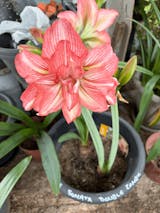
Growing and Caring for Gloriosa (flame lily)
Gloriosa — known as the “flame lily” is one of Africa’s most breathtaking flowers. Gloriosa is derived from the Latin word gloriosus meaning full of glory. This remarkable bloom serves as a tribute to life’s glorious cycles, symbolising fertility, rebirth, and continuity.
As the national flower of Zimbabwe, our neighbouring country, Gloriosa stands out as an extraordinary and highly coveted bulb in the gardening community. Its unique, almost inside-out beauty resembles flickering flames or even a multi-coloured Sputnik gliding through space. With spiralling corkscrew tendrils that climb and striking flowers in shades of orange, saffron yellow, deep red, and vivid pink, its petals curve upwards as if reaching for each other. Accentuated by long, “floating” stamens, this spectacular bloom is a favourite in tropical floral designs.
Here’s our guide to Growing and Caring for Gloriosa (flame lily).
About Gloriosa
The 12 species in this genus all have subtropical or tropical origins, originating from the temperate zones of Africa and west Asia. In South Africa they are prolific in KZN, the Western and Northern Cape, in a range of habitats including humid forests and grassy plains. In the wild, they can get up to around 3m in height, as long as they have support that will enable them to climb. Although tamed in a garden you will see them reaching up to 2m. They are also found sprawling over low bushes and rocks, in thickets and on the savannah. This means that they will handle pretty much any kind of soil, but fertile is always preferable.

How to grow flame lilies in South Africa?
The flowers of G. superba first appear in November, and will keep going until March. They are summer bloomers, and as they are usually found growing up and around trees, are happiest in semi-shade and shady areas. You can cultivate them in a container, just make sure they have support to clamber up. The tuber is usually tucked in fairly deep (about 10cm under the soil level). It will sprout in spring, sending up one to four stems with bright green leaves, tipped with a tendril that hangs on to anything it touches. The stems will die back in late summer and the bulb will go into dormancy until the next season. If you need to thin the tubers out, or you want to propagate, lift the tubers in late winter when the plants are dormant, before they start growing in spring. As with the stems, the tubers can also be delicate and a tad brittle, so handle with care – and wear gloves.This is only necessary every three years.
Thankfully, Gloriosa is pretty low-maintenance for such a glamorous name. Start them off with well-drained, rich soil packed with organic matter, give them a good spot in the garden, and water thoughtfully, every 2-3 days in containers, and every 3-4 days in the garden (provided it hasn’t rained). They are so unfussy, even gardening novices will feel like pros. You can provide them with a healthy dose of Hadeco Bulb food every second week, through the growing season and especially after flowering.
What is Gloriosa used for?
All parts of the plant contain colchicine, which is highly toxic. The plant is known to be used in traditional medicine for a variety of ailments. Just don’t go brewing up homemade concoctions with this poisonous plant.
Is Gloriosa poisonous to touch?
This stunning beauty might look harmless, but its toxicity is no joke. So, do yourself a favour: grab those gardening gloves before you get too hands-on.
Happy gardening!
Disclaimer: Although Gloriosa is used as a traditional medicine in select parts of the world, do bear in mind that EVERY part of the plant is very poisonous to humans and animals, so make sure that none of it is ever ingested. Interestingly, if you have porcupines visiting your garden, they love them and can ingest them with no ill-effects. They will eat anything it seems! When handling the stems or flowers, make sure that you don’t let any sap come into contact with your mouth or eyes as it causes skin irritation.



Leave a comment